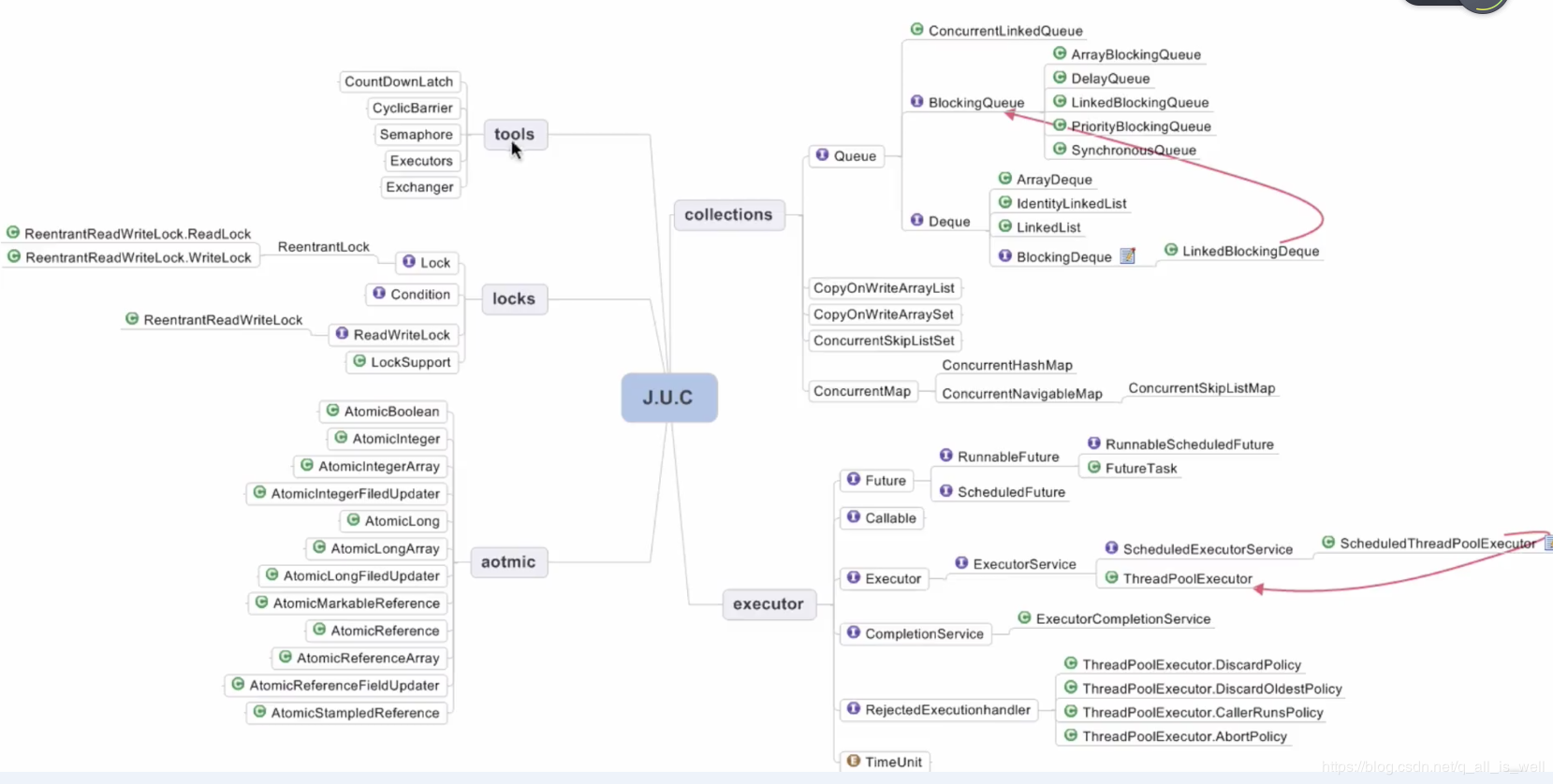Java里的并发容器与安全共享策略总结
一、并发容器
ArrayList --> CopyOnWriteArrayList
概念 : 简单的讲就是写操作时赋值,当有新元素添加到CopyOnWriteArrayList时,它先从原有的数组里边Copy一份出来然后在新的数组上做些操作,操作完成以后在将引用指向新的数组;CopyOnWriteArrayList所有的操作都是在锁的保护下进行的,这样做的目的主要是为了在多线程并发做add操作的时候复制出多个副本出来导致数据混乱;
缺点 :
① 由于是copy的操作所以比较消耗内存,如果元素的内容较多的时候可能会触发GC,
② 不能用于实时读的场景,它比较适合读多写少的场景;
思想 :
① 读写分离;
② 最终一致性;
③ 另外开辟空间解决并发冲突;
// CopyOnWriteArrayList @Slf4j @ThreadSafe public class CopyOnWriteArrayListExample { // 请求总数 public static int clientTotal = 5000; // 同时并发执行的线程数 public static int threadTotal = 200; private static List<Integer> list = new CopyOnWriteArrayList<>(); public static void main(String[] args) throws Exception { ExecutorService executorService = Executors.newCachedThreadPool(); final Semaphore semaphore = new Semaphore(threadTotal); final CountDownLatch countDownLatch = new CountDownLatch(clientTotal); for (int i = 0; i < clientTotal; i++) { final int count = i; executorService.execute(() -> { try { semaphore.acquire(); update(count); semaphore.release(); } catch (Exception e) { log.error("exception", e); } countDownLatch.countDown(); }); } countDownLatch.await(); executorService.shutdown(); log.info("size:{}", list.size()); } private static void update(int i) { list.add(i); } }
HashSet --> CopyOnWriteArraySet 与 TreeSet --> ConcurrentSkipListSet
概念 :
CopyOnWriteArraySet它是线程安全,底层实现是使用CopyOnWriteArrayList,它的很多特性都与CopyOnWriteArrayList相似包括适用场景;
ConcurrentSkipListSet是jdk6新增的类,支持自然排序,可以在构造的时候自己定义比较器,它是基于Map集合的,在多线程环境下ConcurrentSkipListSet它里边的remote add 等方法都是线程安全的,但是对于批量操作并不能保证以原子方式进行操作,在批量操作的时候只能保证每一次的操作是原子性的;ConcurrentSkipListSet在使用批量操作的时候可能需要手动处理一下;
// CopyOnWriteArraySet @Slf4j @ThreadSafe public class CopyOnWriteArraySetExample { // 请求总数 public static int clientTotal = 5000; // 同时并发执行的线程数 public static int threadTotal = 200; private static Set<Integer> set = new CopyOnWriteArraySet<>(); public static void main(String[] args) throws Exception { ExecutorService executorService = Executors.newCachedThreadPool(); final Semaphore semaphore = new Semaphore(threadTotal); final CountDownLatch countDownLatch = new CountDownLatch(clientTotal); for (int i = 0; i < clientTotal; i++) { final int count = i; executorService.execute(() -> { try { semaphore.acquire(); update(count); semaphore.release(); } catch (Exception e) { log.error("exception", e); } countDownLatch.countDown(); }); } countDownLatch.await(); executorService.shutdown(); log.info("size:{}", set.size()); } private static void update(int i) { set.add(i); } }

// ConcurrentSkipListSet @Slf4j @ThreadSafe public class ConcurrentSkipListSetExample { // 请求总数 public static int clientTotal = 5000; // 同时并发执行的线程数 public static int threadTotal = 200; private static Set<Integer> set = new ConcurrentSkipListSet<>(); public static void main(String[] args) throws Exception { ExecutorService executorService = Executors.newCachedThreadPool(); final Semaphore semaphore = new Semaphore(threadTotal); final CountDownLatch countDownLatch = new CountDownLatch(clientTotal); for (int i = 0; i < clientTotal; i++) { final int count = i; executorService.execute(() -> { try { semaphore.acquire(); update(count); semaphore.release(); } catch (Exception e) { log.error("exception", e); } countDownLatch.countDown(); }); } countDownLatch.await(); executorService.shutdown(); log.info("size:{}", set.size()); } private static void update(int i) { set.add(i); } }
HashMap --> ConcurrentHashMap 与 TreeMap --> ConcurrentSkipListMap
概念 :
ConcurrentHashMap是HashMap线程安全的版本,ConcurrentHashMap不允许空值,在实际的应用中除了少数的插入操作和删除操作外,绝大多数操作都是读取操作,而且读操作大多数都是成功的,基于这个前提ConcurrentHashMap针对读操作多了特别多的优化,具有特别高的并发性;
ConcurrentSkipListMap是TreeMap线程安全的版本,ConcurrentSkipListMap底层是使用SkipList这种跳表的结构实现的;
// ConcurrentHashMap @Slf4j @ThreadSafe public class ConcurrentHashMapExample { // 请求总数 public static int clientTotal = 5000; // 同时并发执行的线程数 public static int threadTotal = 200; private static Map<Integer, Integer> map = new ConcurrentHashMap<>(); public static void main(String[] args) throws Exception { ExecutorService executorService = Executors.newCachedThreadPool(); final Semaphore semaphore = new Semaphore(threadTotal); final CountDownLatch countDownLatch = new CountDownLatch(clientTotal); for (int i = 0; i < clientTotal; i++) { final int count = i; executorService.execute(() -> { try { semaphore.acquire(); update(count); semaphore.release(); } catch (Exception e) { log.error("exception", e); } countDownLatch.countDown(); }); } countDownLatch.await(); executorService.shutdown(); log.info("size:{}", map.size()); } private static void update(int i) { map.put(i, i); } }

// ConcurrentSkipListMap @Slf4j @ThreadSafe public class ConcurrentSkipListMapExample { // 请求总数 public static int clientTotal = 5000; // 同时并发执行的线程数 public static int threadTotal = 200; private static Map<Integer, Integer> map = new ConcurrentSkipListMap<>(); public static void main(String[] args) throws Exception { ExecutorService executorService = Executors.newCachedThreadPool(); final Semaphore semaphore = new Semaphore(threadTotal); final CountDownLatch countDownLatch = new CountDownLatch(clientTotal); for (int i = 0; i < clientTotal; i++) { final int count = i; executorService.execute(() -> { try { semaphore.acquire(); update(count); semaphore.release(); } catch (Exception e) { log.error("exception", e); } countDownLatch.countDown(); }); } countDownLatch.await(); executorService.shutdown(); log.info("size:{}", map.size()); } private static void update(int i) { map.put(i, i); } }

二、J.U.C的实际构成

三、安全共享对象策略总结
1 线程限制 : 一个被线程限制的对象,由线程独占,并且只能被占有它的线程修改;
2 共享只读 : 一个共享只读的对象,在没有额外同步的情况下,可以被多个线程并发访问,但是任何线程都不能修改它;
3 线程安全对象 : 一个线程安全的对象或者容器,在内部通过同步机制来保证线程安全,所以其他线程无需额外的同步就可以通过公共接口随意访问它;
4 被守护对象 : 被守护对象只能通过获取特定的锁来访问;


